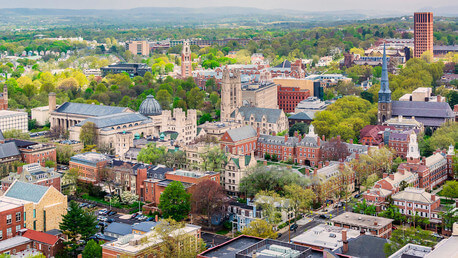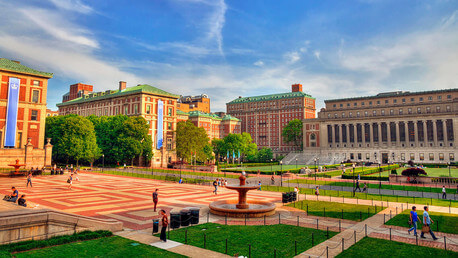


Dartmouth College
Overview
A top-ranked medical program and business school crown Dartmouth College’s liberal arts education. This Ivy League school, the second youngest but also the smallest, is located in Hanover, NH, where it’s easily the main attraction in town.
The Flexible D-Plan Class Structure
With a 10 percent acceptance rate, it’s a hard-earned victory to receive an admissions letter from this Ivy. In return, Dartmouth College arguably rewards its students with a multitude of opportunities, many of which are made available through the institution's unique D-Plan class structure. Dartmouth offers 45 majors through six departments, as well as minors and a format to customize majors, either called “Modified” or “Special.”
Dartmouth runs courses throughout the entire year and students can choose which quarters they want to spend on the Hanover campus. To graduate, students must complete twelve 10-week quarters, but only seven of them are required to be spent on the physical campus. This flexibility provides a number of opportunities for students to study abroad, resulting in more than half of Dartmouth’s student body studying abroad during their tenure at the college. Financial aid also follows students anywhere they go, making it easy to venture off-campus.
The D-Plan also allows students to pursue internships during any quarter of the year, with help from the Dartmouth Center for Professional Development, the Alumni Career Network, Center for Social Impact, Dickey Center for International Understanding, and more.
Undergraduate Advising and Research (UGAR)
Undergraduates at Dartmouth can take advantage of their Robust Research Infrastructure to get involved in research. Undergraduate Advising and Research (UGAR) pairs students with professors to work 1-on-1 and foster mentoring relationships, while the Women in Science Project (WISP) focuses on women interested in STEM fields. Students can also take advantage of research grants for a variety of reasons, including to do full-time research, part time assistantships, and thesis research.
The Dartmouth Great Outdoors
With a river on one side and mountains on the other, Dartmouth takes advantage of its location with long-standing programs like the Dartmouth Outdoors Club (DOC), which also plays a key role in Dartmouth’s commitment to bonding classmates through First-Year Trips. This emphasis on unity flows neatly into the institution’s drive to foster leaders who create a community based on scholarship and life-long learning.
The 237-acre campus boasts “The Green” at the apex, the famous box of lawn criss-crossed with walkways, where this institution holds its popular carnivals—four a year that let students loosen up and come together. For those attending classes in the summer, it’s also home to a weekly farmer’s market. It’s all overlooked by the Baker Tower which features that Baker Bells, which play the Alma Mater at 6 pm. Reportedly, the bells also take requests and have been heard to play “Hogwarts Forever” from Harry Potter.
"The Big Green"
Throughout the years, “The Green” became more than a gathering place. In 1970, it also inspired the nickname for Dartmouth’s 35 athletic teams, known officially as “The Big Green.” Playing in NCAA Division 1, the campus features a number of facilities to support the teams, including the Boss Tennis Center, Corey Ford Rugby Clubhouse, Berry Center squash courts, and McLane Skiway Lodge.
Finding it difficult to dress up as “The Big Green,” though, an unofficial mascot was chosen in 2003: Keggy the Keg (which, yes, is a very large beer keg). Unsurprisingly, it was chosen by the humor mag of the institution, the Dartmouth Jack-O-Lantern, which was once headed by Theodore Geisel, class of 1925, more commonly known by his pseudonym, Dr. Suess.
Virtual Tour
Tuition, Cost & Aid
Affordability & Cost
Discover how military service can help you pay for college
Explore Military Pathways| In-State Tuition In-state tuition is the tuition charged by institutions to those students who meet the state's or institution's residency requirements. In-district tuition is the tuition charged by the institution to those students residing in the locality in which they attend school and may be a lower rate than in-state tuition if offered by the institution. | $65,511 |
| Out-of-State Tuition Out-of-state tuition is the tuition charged by institutions to those students who do not meet the state’s or institution’s residency requirements. Out-of-district tuition is the tuition charged by the institution to those students not residing in the locality in which they attend school. | $65,511 |
Room and Board The weighted average for room and board and other expenses is generated as follows:
| $19,009 |
| Books and Supplies | $1005 |
Aid & Grants
Student Loans
Admissions
Key Admissions Stats
- Not for Profit
- Coed
Need Aware
This school may consider an applicant’s financial situation when deciding admission
Admissions Requirements
Important Deadlines
| Application Type | Application Deadline | Reply Deadline |
|---|---|---|
| Early Decision Acceptance is binding so student must attend college if accepted. | November 1 | |
| Fall Regular Decision | January 2 | May 1 |
Admitted Student Stats
Admissions Resources
Academics
Key Academic Stats
- Online Classes
- Summer Sessions
- Combined Institution Double Degree Programs
- ROTC Army
- Study Abroad
- Honors Program
Degrees and Majors
Majors
| A B M D | |
|---|---|
| AREA, ETHNIC, CULTURAL, GENDER, AND GROUP STUDIES | |
| BIOLOGICAL AND BIOMEDICAL SCIENCES | |
| BUSINESS, MANAGEMENT, MARKETING, AND RELATED SUPPORT SERVICES | |
| COMPUTER AND INFORMATION SCIENCES AND SUPPORT SERVICES | ✓ ✓ ✓ |
| ENGINEERING | |
| ENGINEERING/ENGINEERING-RELATED TECHNOLOGIES/TECHNICIANS | |
| ENGLISH LANGUAGE AND LITERATURE/LETTERS | |
| FOREIGN LANGUAGES, LITERATURES, AND LINGUISTICS | |
| HEALTH PROFESSIONS AND RELATED PROGRAMS | |
| HISTORY | |
| LIBERAL ARTS AND SCIENCES, GENERAL STUDIES AND HUMANITIES | |
| MATHEMATICS AND STATISTICS | |
| MULTI/INTERDISCIPLINARY STUDIES | |
| NATURAL RESOURCES AND CONSERVATION | |
| PHILOSOPHY AND RELIGIOUS STUDIES | |
| PHYSICAL SCIENCES | |
| PSYCHOLOGY | |
| SOCIAL SCIENCES | |
| VISUAL AND PERFORMING ARTS |
Faculty Overview
Campus Life
Key Campus Stats
Housing
Athletics
- Baseball
- Basketball
- Crew-Rowing
- Football
- Golf
- Ice Hockey
- Lacrosse
- Skiing-Snowboarding
- Soccer
- Swimming
- Tennis
- Track and Field
- Squash
- Sailing
- Basketball
- Crew-Rowing
- Equestrian
- Field Hockey
- Golf
- Ice Hockey
- Lacrosse
- Skiing-Snowboarding
- Soccer
- Softball
- Swimming
- Tennis
- Track and Field
- Volleyball
- Squash
- Sailing
Campus Safety
After Graduation
Post Grad Stats
REVIEWS
Read What Students Are SayingSince we are on the quarter system, classes are fast paced, but it is nice that you only have 3 per quarter. As much learning goes on outside of lecture as does during lecture. Plentiful office hours, study groups, and labs enrich one's learning experience. Professors truly care and want you to do well, so they offer help whenever possible. They also want you to learn how to think and problem solve as opposed to simply memorizing. Exams are designed to test thinking skills by applying concepts learned in class rather than just regurgitating information.
The D-Plan also allows me to take more classes than at other colleges and allows pre-meds (gasp!) to study abroad, possibly twice! This is almost unheard of at other colleges.
Similar Colleges
 Philadelphia, PA
Philadelphia, PA Providence, RI
Providence, RI Stanford, CA
Stanford, CA New Haven, CT
New Haven, CT Cambridge, MA
Cambridge, MA Princeton, NJ
Princeton, NJ New York, NY
New York, NY Ithaca, NY
Ithaca, NY New York, NY
New York, NY Durham, NC
Durham, NC